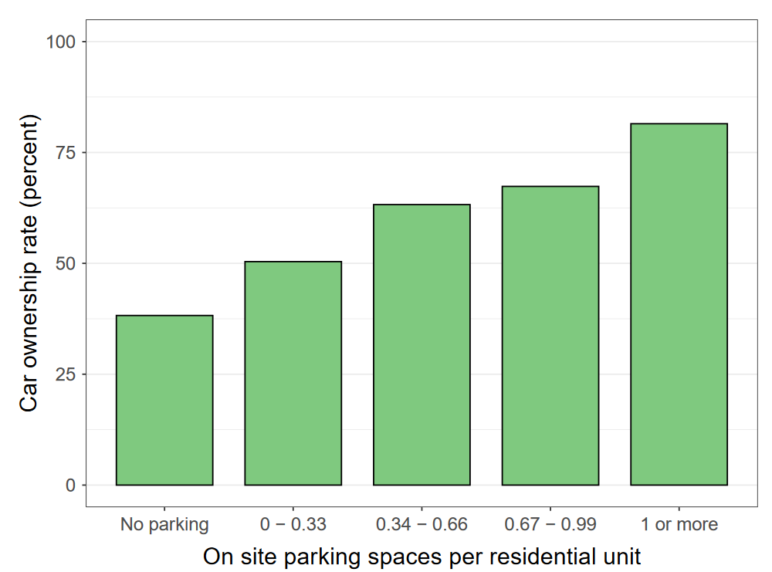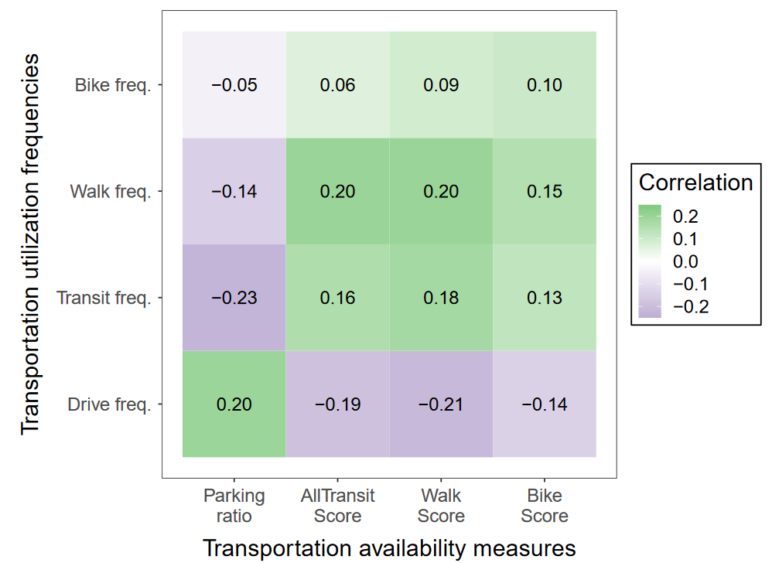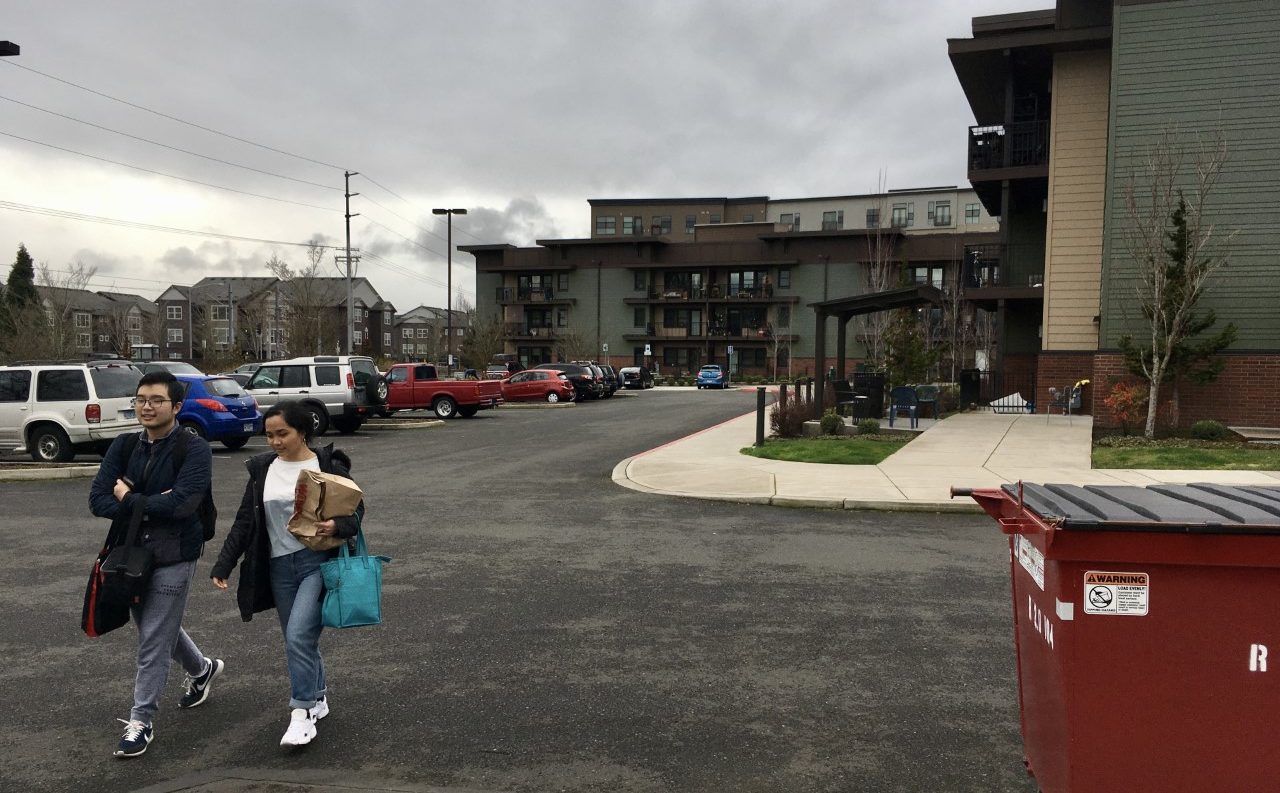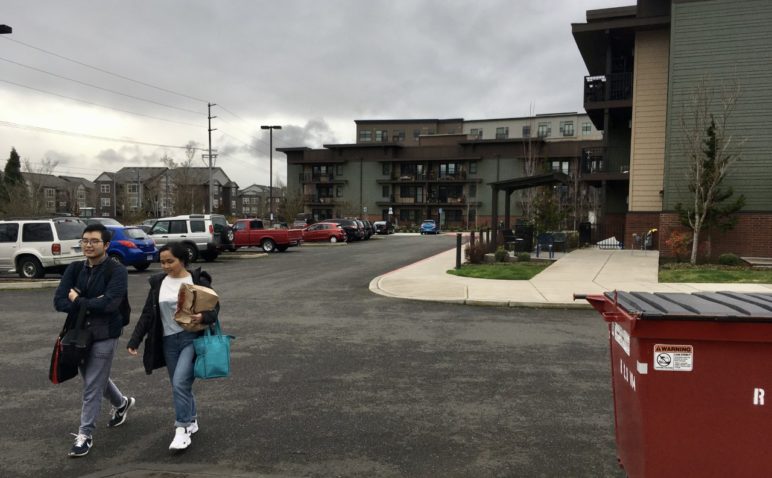Do cities create greener lifestyles? Or do they just enable them?
It’s very, very, very clear that people who live closer to other people drive less. But how much of this is due to the fact that people who were already predisposed to driving less—those of us who don’t particularly enjoy driving, for example—are deliberately living where parking is scarce and buses are frequent?
A forthcoming academic paper finally begins to answer this crucial question. Its “breakthrough” conclusion: Bigger parking lots make us drive more.
Even if we ignore the breathtaking economic costs of dedicating scarce urban space to car storage, mandatory parking isn’t an “all of the above” strategy that simply lets people choose their favorite mode of transportation. Instead, as UCLA professor Donald Shoup put it in 1997, parking spaces are “a fertility drug for cars.”
Our buildings shape our behavior
Speaking scientifically, the key to proving a cause-and-effect relationship is finding a randomized sample of human behavior.
And in their new paper, “What Do Residential Lotteries Show Us About Transportation Choices?”, four Californian academics found such a sample: the free, site-specific lotteries that San Francisco uses to select who gets to live in the price-regulated homes of new apartment and condo buildings. (Because this is San Francisco, a two-person household “generally can qualify while earning up to $118,200, equivalent to 120 percent of city median income.” So these findings don’t apply only to people who would struggle to afford a car.)
“It’s so hard to do this kind of research,” wrote Jessica Roberts, a principal at Portland-based Alta Planning + Design and one of the country’s leading experts on the science of transportation behavior. “Their elegant experimental design is a huge breakthrough.”
After surveying the auto ownership and basic transportation habits of the residents of 2,654 homes in 197 projects built since 2002, the authors (Adam Millard-Ball, Jeremy West, Nazanin Rezaei, and Garima Desai) found that projects with more on-site parking induce more auto ownership:

Image: Millard-Ball, West, Rezaei and Desai. Used with permission.
“Buildings with at least one parking space per unit (as required by zoning codes in most U.S. cities, and in San Francisco until circa 2010) have more than twice the car ownership rate of buildings that have no parking,” the authors write.
Do buildings with less parking and car ownership limit the job prospects of their occupants? Apparently not. The team found no correlation between parking supply and employment status at the time of their 2019 survey.
They also found that more parking led to more driving, less transit use, and less walking. And they checked the locations of the 197 projects and found that non-automotive transportation choices seem to be induced by higher AllTransit scores (a measure of nearby mass transit quality by street address), higher WalkScores (a measure of the diversity of destinations within walking distance, inspired in part by an old Sightline blog post), and higher BikeScores (a measure of the quality of nearby bike networks).

Image: Millard-Ball, West, Rezaei and Desai. Used with permission.
It’s not just that people who enjoy walking to the store will choose to live near stores. It’s that living near stores makes us more inclined to walk, and less inclined to drive.
“We shape our buildings,” Winston Churchill said. “And afterward, our buildings shape us.”
This addresses one of the most important questions in urban environmentalism
This paper doesn’t close the book on the questions of how much our buildings shape us, and in which ways, and which of us they shape more or differently. It’s one study in one city from one year.
But it is a big new confirmation of one of the central hypotheses of the modern pro-housing movement.
We’ve known that Amsterdam, built mostly before the automobile was invented, has much lower energy use per person than Seattle, despite their comparable population and wealth. We’ve known that this pattern holds within countries, too. When you’re measuring greenhouse emissions per person within a country, density is all but destiny. We’ve known that if everyone on the world could consume energy like Netherlanders rather than like Cascadians, it would be far easier to find our way to a planet that can remain both prosperous and habitable for human life.
But at least in the United States, there hasn’t actually been much solid evidence that building cities differently will actually change our behavior enough.
This new study strongly suggests that it’s possible, all these centuries later, to build new Amsterdams.










Ruth Williams
This makes sense, but put into practice it leaves Seattle north of 85th with a problem. Lots of development with minimal parking is already going on, but there are no sidewalks up here.
We need some provision to keep the public rights of way from being choked with parked cars.
And this needs to be put in place sooner rather than later. After too many of these newer buildings are occupied and this being Seattle, a strong lobby opposing public parking restrictions is likely to develop.
Check out 3035925-LU; 10631 8th Ave NE, with limited parking and access only on 8th NE. This portion of 8th NE is narrow and a designated greenway with a two-way bike lane down the middle. (http://www.seattle.gov/transportation/projects-and-programs/programs/greenways-program/northgate) The development itself is also within the buffer zone of Thornton Creek.
John James O'Brien
It is very important to distinguish between residential streets that are intended to be connecting thoroughfares and those that are intended to be places for community life and wellness. A route to get from A – B is very different from a street that is a place of community engagement, kids learn to ride bikes, seniors st/roll and folks with toddlers in strollers can walk three abreast in conversation.
We’re creating such a zone in Victoria BC on a set of contiguous sidewalk-free streets and the improvement in the sense of community, resilience during the pandemic and such crises, increase in safety due to discouraging drivers with no local purpose and engaging with (neighbourhood) drivers who do; reduced risk of petty crime through a cohesive sense of belonging. Love it @oaklandsrise #woonerf – but that said, we’ve mapped our relationship to connector roads and arterials (1-3 blocks) where the thoroughfare is a transportation route, not a “living yard”.
John Niles
Thanks for taking a close look at private car parking.
In the real world I have lived in over my entire lifetime, I’ve heard people who drive cars say pretty frequently, “I don’t go there because there is no parking.” Or sometimes, “…because parking is too expensive.” In some cases, like to many CBDs including Seattle’s, public transit is an option to avoid expensive parking. That’s what I do.
But to summarize, for car drivers, availability of accessible and affordable parking at both ends of trips is as critically important as having roads between origins and destinations. Congestion pricing on roads and high parking prices constrain car use, per Economics 101. The only question is by how much, and of course that varies.
My guess is that parking constraints at particular locations in high automobile use countries cause avoidance by car owners of those particular locations, whether choices in where to live, or choices of destinations.
My hypothesis for your consideration is that such constraints cause shifts in land use choices brought on by strong mobility preferences, for example more suburbanization, or lower take rates than the regional average in certain residential complexes seeking tenants who don’t want parking.
At the same time I would hypothesize that parking constraints do NOT generate broad shifts away from the existing strong preference for automobile use across such countries. Have you spotted any research bearing on my hypotheses?
Of course wealthier people bear the costs of tolls, road user fees, and high parking fees better than the less wealthy, so equity issues bear importantly here.
At least peripherally relevant, bearing on the preference for automobile use is Eric A. Morris, Evelyn Blumenberg, and Erick Guerra, “Does Lacking a Car Put the Brakes
on Activity Participation? Private Vehicle Access and Access to Opportunities Among Low-Income Adults,” Transportation Research Part A: Policy and Practice 136 (June 2020): 375–397. https://doi.org/10.1016/j.tra.2020.03.021
Heads up on my own research coming out soon in a new study from Mineta Transportation Institute: The influence of 100 parking spaces on morning weekday transit ridership computes to 2.4 times that of 100 near-transit housing units for Santa Clara Valley Transit (in San Jose) and 1.9 times for Los Angeles County Metro. For King County Metro the ridership influence ratio of parking over housing is 4.0.
Michael Andersen
I agree that inconvenient parking options probably deflect more auto trips than they actually reduce.
This is a big reason I’m not arguing that parking should be “constrained,” only that it should be optional. Individual sites should make site-specific decisions about their optimal amount of parking. But a key implication of the study I wrote about above is that governments shouldn’t protect aggregate parking supply – the net effect of additional parking probably works out to an overall cost on society due to the additional congestion and pollution.
As for your upcoming research, cool. I think it’s great to put numbers on those forces. The question for me though is also how the cost per induced transit trip from those 100 parking spaces compares to potential investments in more service, dedicated lanes & signals or lower fares. Any findings on that?
John Niles
My research with San Jose State University Professor Mike Pogodzinski on park-and-ride influence on transit ridership in Seattle, San Jose, and Los Angeles, along with looking also at housing density influence on transit ridership, has been released. Here’s the press release which points to the research summary and the full report: https://transweb.sjsu.edu/press/Transit-Oriented-Developments-v.-Park-and-Rides-which-Appropriate-Where
John James O'Brien
The variables that apply in a given context make it difficult to comment…one size does not fit all. Having lived overseas in Asia and with activity that placed me in Europe for lengths of time over the years, with a pretty broad association with places in North America, I have come to this:
– public transportation needs to be present, convenient, safe and frequent, consisting of a variety of types well integrated to achieve the objectives of moving people (and perhaps goods)
– stages of life apply to need for personal or limited share vehicles, again within context; need for workplace vehicles relates to the public transportation, and other variables, not least of which is an entirely different approach to time (again in context- I could let the heat and my ego put me in a drivers hands for 45 minutes in traffic, or, walk 10 minutes down the street); multiple vehicles? much to explore in social psyche beyond actual need…
– NOT providing a space where the vehicle lives means that they will park somewhere else, again context specific. Where I live, we lack adequate public transportation and depend economically on people getting out of the centre to experience the surrounding area, and have a shortage of day care and such services that mean driving more than should be necessary. While some certainly opt for no care/car share, there’s a visible shift to EV. Getting all off the road will come when the cars are not needed (as was the case when living in HKG where the infrastructure and variety of public transport is efficient with a range of affordability that invites all, and cars are more about status than transportation).
Kingeider
San Francisco or Seattle are not models for most cities. Lack of on site parking just spills over parking onto streets. More crowded, more dangerous for bikes and pets.
Michael Andersen
I know the bike safety literature fairly well, and I’ve never seen anything suggesting that a partially occupied parking lane is more dangerous than a fully occupied parking lane. Have you?
Alec
Unlike what this article suggests, the Urban Studies article noted does not measure an amount of driving at all. It measures car ownership.
Michael Andersen
It measures both. The first chart above shows the car ownership finding. The second chart shows the amount of driving.
Anthony
Here in Hertford, UK, we see two or three cars parked outside houses which were built before cars were invented. Accordingly the appearance of such streets is horrendous and makes bike-riding – my own method of transport – hazardous as I move outside the parked cars. |Good-natured communication between cyclists and drivers is crucial.
Even so there seems no chance of the situation improving without large numbers of residents concreting over their gardens. This has other implications as well … but enough for now.
Michael Andersen
Here in Portland, OR, we see one or two cars parked outside houses which were built after off-street parking was mandatory. Though it’d be very convenient if parking mandates emptied the curbsides, they don’t: https://www.sightline.org/2022/04/27/one-in-three-garages-has-no-car-in-it/